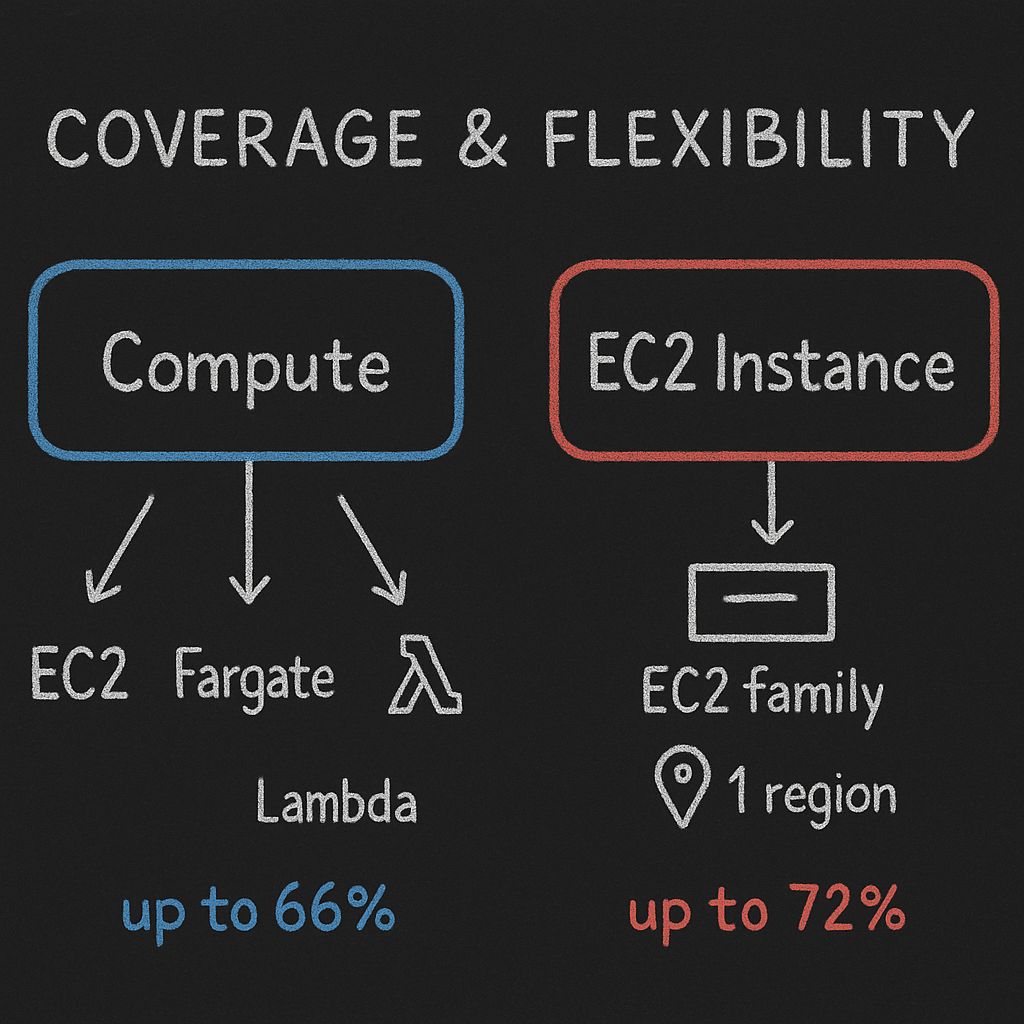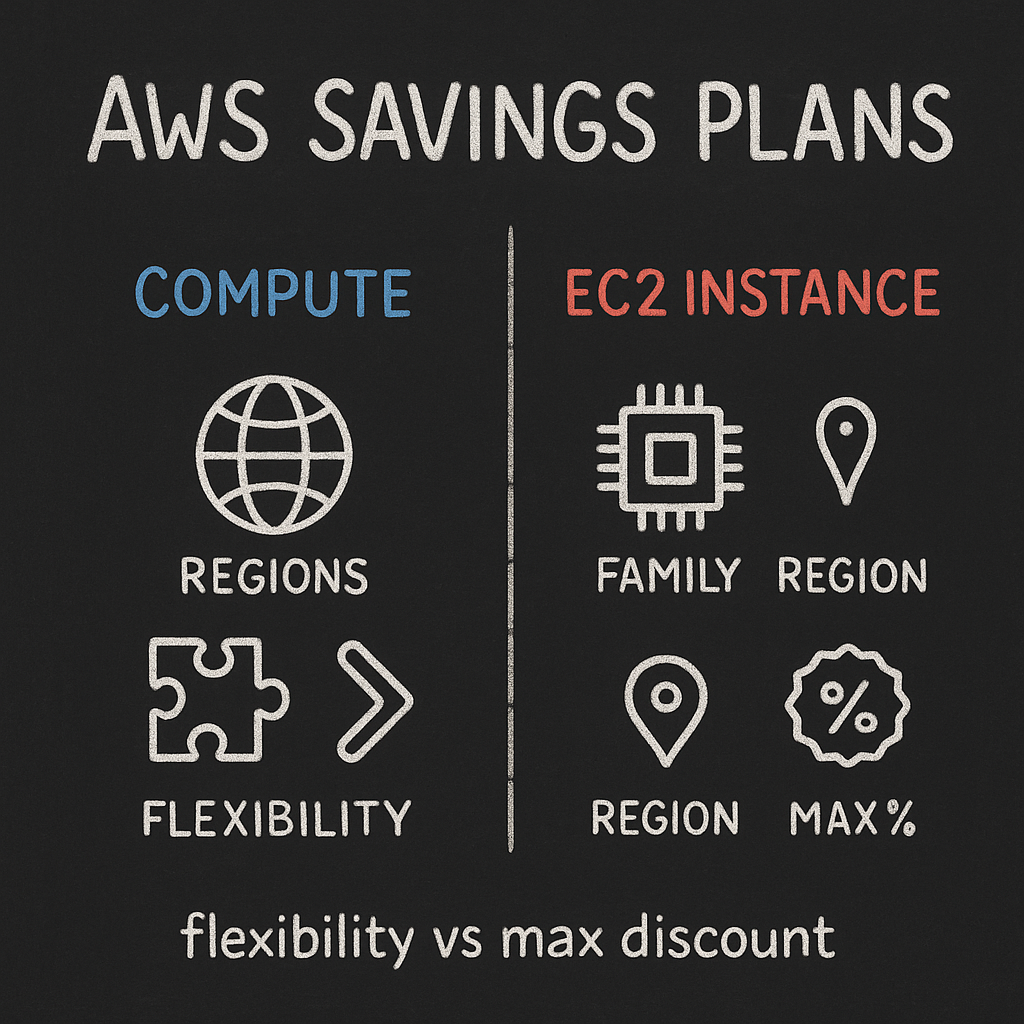AWS Compute Savings Plans vs EC2 Instance Savings Plans: Which is right for your workloads?
Are you struggling to decide between AWS Compute Savings Plans and EC2 Instance Savings Plans? You’re not alone. Many AWS users find themselves weighing flexibility against maximum savings, uncertain which plan will deliver the best value for their unique workloads.
This guide breaks down the key differences, helping you make an informed decision that balances cost optimization with your specific operational needs.
What are AWS Savings Plans?
AWS Savings Plans are flexible pricing models that offer significant discounts compared to On-Demand rates in exchange for a commitment to use a specific amount of compute power for a 1-year or 3-year term.
Compute Savings Plans
Compute Savings Plans provide the greatest flexibility across your AWS compute services. They offer:
- Coverage for EC2 instances regardless of instance family, size, OS, tenancy, or AWS Region
- Support for AWS Fargate and AWS Lambda usage
- Application to EC2 instances running in Amazon EMR, EKS, and ECS clusters
- Savings of up to 66% compared to On-Demand pricing
EC2 Instance Savings Plans
EC2 Instance Savings Plans are more restrictive but can offer deeper discounts:
- Limited to a specific EC2 instance family within a chosen region
- Cover all instance sizes, OS types, and tenancy options within that family/region
- Savings of up to 72% compared to On-Demand pricing
- Not applicable to Fargate or Lambda services
Key differences: Coverage, flexibility, and savings

| Feature | Compute Savings Plans | EC2 Instance Savings Plans |
|---|---|---|
| Coverage | EC2, Fargate, Lambda across all regions | Specific EC2 instance family in one region |
| Flexibility | Change instance types, regions, or move to Fargate/Lambda | Change only instance sizes within the same family and region |
| Maximum discount | Up to 66% | Up to 72% |
| Commitment types | 1 or 3 years | 1 or 3 years |
| Payment options | All upfront, partial upfront, no upfront | All upfront, partial upfront, no upfront |
Which plan should you choose?

Choose Compute Savings Plans when:
Your workloads span multiple instance families or you need geographical flexibility to move between regions. These plans are ideal if you use or might include Fargate or Lambda in your architecture. If you’re modernizing applications or have frequently changing workload requirements, the flexibility of Compute Savings Plans becomes invaluable.
Compute Savings Plans shine in diverse environments. For instance, if you’re currently using C4 instances but plan to migrate to M5 instances, these plans would continue to apply discounts during and after this transition. Similarly, if you need to shift workloads between EU Ireland and EU London regions, your savings remain intact.
Choose EC2 Instance Savings Plans when:
Your workloads primarily use a specific instance family in a single region and you’re seeking the maximum possible discount. These plans work best when your usage patterns are stable and predictable, and you don’t use or plan to use Fargate or Lambda.
EC2 Instance Savings Plans are perfect for organizations with consistent workloads. For example, if you run a data processing application that consistently uses R5 instances in us-east-1, an EC2 Instance Savings Plan would maximize your savings while still allowing you to switch between different R5 sizes as needed.
Practical cost/benefit analysis
To understand the potential impact on your AWS bill, consider this simplified example:
Scenario: $10,000/month On-Demand EC2 spend
| Plan Type | Commitment | Potential Monthly Savings | Annual Savings | Flexibility |
|---|---|---|---|---|
| Compute (1-year) | $6,000/month | $4,000 (40%) | $48,000 | High |
| EC2 Instance (1-year) | $6,000/month | $4,400 (44%) | $52,800 | Limited |
| Compute (3-year) | $6,000/month | $5,000 (50%) | $60,000 | High |
| EC2 Instance (3-year) | $6,000/month | $5,400 (54%) | $64,800 | Limited |
While EC2 Instance Savings Plans offer higher savings in this example, you must weigh this against the reduced flexibility. For workloads that might evolve or migrate between instance families, the additional flexibility of Compute Savings Plans may ultimately provide better value despite the lower headline discount.
One manufacturing company reduced its forecasted AWS spend by 43% using a 3-year Compute Savings Plan, demonstrating the real-world impact these commitments can have on your bottom line.
How to select the right plan
Analyze your current usage patterns using AWS Cost Explorer to understand your spending across instance families and regions. Look for patterns in your usage over the past 3-6 months to establish a baseline.
Consider your future needs by asking key questions: Are you planning major architecture changes? Might you adopt new services like Fargate or Lambda? Do you anticipate regional expansion?
Calculate potential savings using AWS Cost Explorer’s Savings Plans recommendations feature to compare different commitment levels and term lengths. Start with a conservative commitment covering 70-80% of your baseline usage initially—you can always purchase additional Savings Plans as needed.
Combine plans strategically, knowing that EC2 Instance Savings Plans are applied before Compute Savings Plans. Consider using EC2 Instance Plans for stable workloads and Compute Plans for the rest of your portfolio.
Important operational considerations
AWS treats Reserved Instances (RIs) and Savings Plans as complementary tools. RIs apply first to eligible usage, then Savings Plans cover remaining eligible usage. This priority system ensures you maximize discounts without double-counting. Learn more about the differences between Savings Plans and Reserved Instances.
AWS automatically applies your Savings Plans to the highest discount eligible usage first, maximizing your savings without manual intervention. The system groups all active Savings Plans together and treats them as one commitment pool, simplifying management.
Before committing to any Savings Plan, optimize your instance sizes. AWS cost management best practices suggest that right-sizing can reduce compute costs by 30-50%, creating a solid foundation for your Savings Plans strategy.
Combining with other cost optimization strategies
For comprehensive cost optimization, consider combining Savings Plans with storage optimization. AWS EBS performance optimization can significantly reduce storage costs by selecting appropriate volume types and tuning IOPS.
For non-critical, interruptible workloads, Spot Instances can offer savings of up to 90% on batch processing, CI/CD pipelines, and development environments.
Larger organizations may qualify for the AWS Enterprise Discount Program, which can provide additional discounts on top of Savings Plans.
In some cases, evaluating AWS vs GCP pricing or AWS vs Azure performance might reveal opportunities for workload optimization across platforms.
Taking the next step
Making the right choice between AWS Compute Savings Plans and EC2 Instance Savings Plans requires balancing immediate savings against long-term flexibility. While EC2 Instance Savings Plans offer slightly higher discounts (up to 72% versus 66%), Compute Savings Plans provide the freedom to evolve your architecture without sacrificing cost benefits.
For many organizations, a mixed approach works best—using EC2 Instance Savings Plans for stable, predictable workloads and Compute Savings Plans for everything else. Organizations implementing robust forecasting alongside budgeting typically achieve 20-30% more accurate financial planning, making your Savings Plans strategy even more effective.
Need help optimizing your AWS spending beyond Savings Plans? Hykell specializes in automated AWS cost optimization, helping you identify inefficiencies and implement best practices that can reduce your cloud costs by up to 40%—all without compromising performance.
